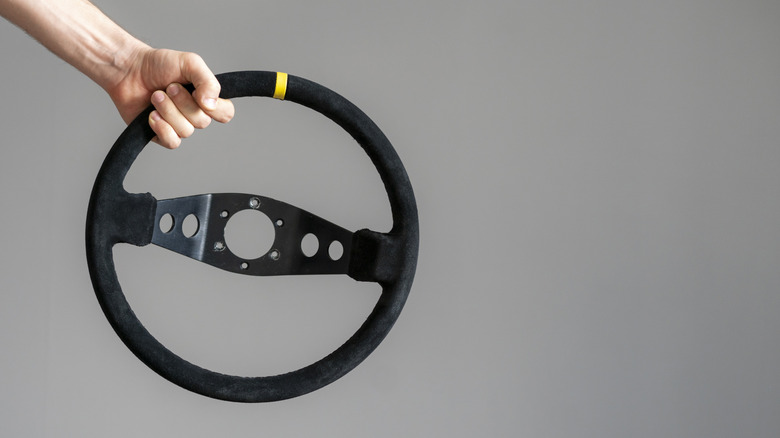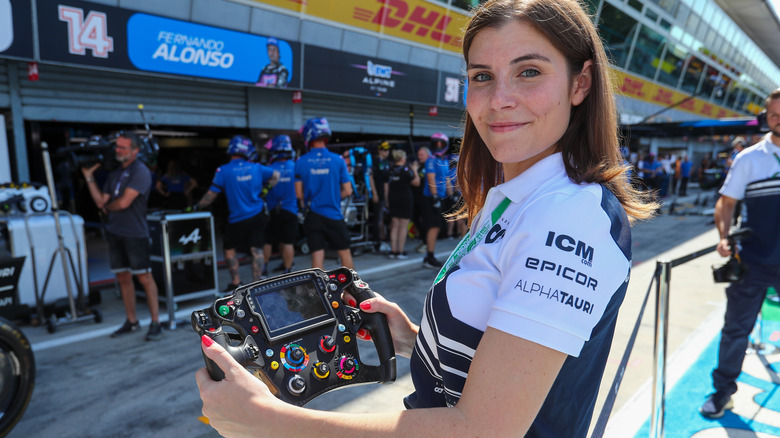Modern Formula 1 steering wheels are more complicated than the U.S. tax code. Operating all the buttons and switches while navigating a race course is like conducting an orchestra, except that conductors don’t fear hitting a wall at 200 mph if they fail to bring in the bassoons on time. Juan Manuel Fangio didn’t have this fighter-jet array of buttons, so why all the controls? And given the variety of shapes, shouldn’t it really be the F1 steering squircle, yoke, or butterfly?
Well, all those buttons and shapes do have a purpose, and there’s nothing superfluous. Though wheels and buttons differ, common controls include the drag-reduction system (DRS), pit-lane speed limiter, “Pit Confirm” (to alert the team about impending pit stops), front/rear brake balance, shift to neutral, “Race Start” to deploy maximum power at the beginning of a race, the radio for calling the team, HPP rotary dials to change energy management, differential torque transfer adjustment, increase or decrease engine braking, mark data points, and funnel hydrating fluids into the driver’s mouth. Paddles shift gears and engage the clutch.
There are also “Skip 1/10 Preset” and “Accept” buttons that operate various sensors, Strat dials for specific combinations of settings, and menu rotary dials to control the screen, which shows info such as lap times, speed, and settings. Depending on the manufacturer, the screen might be mounted to the wheel or, as is the case with the Williams Racing team, on the dash to reduce rotational mass. Mercedes even developed a trick F1 steering system where the driver could push or pull on the wheel to alter the toe angle, but it was banned even faster than the Dodge Daytona from NASCAR, lasting a single season in 2020.
From simple circle to futuristic
Until the 1980s, the F1 wheel was mostly just, well, a wheel. There were small advancements, such as altering the shape and material to provide better grip. Then came ignition kill switches in case the throttle got stuck, followed by boost features during the turbo era, car-to-pit radio controls, and quick-release mechanisms.
With the advent of paddle shifters in the 1989 Ferrari 640, everyone realized it’s awesome when drivers never have to take their hands off the wheel. Plus, eliminating the shift lever and its linkage made the car lighter. In 1994, the Jupiter brains at McLaren thought, “What if we moved the clutch from the pedalbox to the wheel?” It might not seem like a big deal since the clutch is just used during starts, but removing a pedal lets designers make the car even slimmer and more aerodynamic.
Speaking of aerodynamics, the DRS button appeared in 2011. Employing DRS reduces drag on the active rear wing to increase top speed during overtaking maneuvers within specific DRS zones on a Formula 1 track. The rules are changing for 2026, though, and DRS is out — replaced by “Manual Override”, which will use the hybrid system to give the car an extra kick.
Wait, how is “Manual Override” different from the “Overtake” button mentioned by Evan Short in 2020 when he was discussing Lewis Hamilton’s steering wheel on the Mercedes-AMG Petronas Formula One Team YouTube channel? Contemporary reports also said that teams could still use “Overtake” buttons as long as they affected electric energy usage, not the internal combustion engine. Perhaps the elimination of DRS makes the Manual Override/Overtake necessary? Yet, Formula1.com reports that the new active aero behaves pretty much identically to DRS, so if you’re an engineer, please feel free to comment.
There’s no single, universal set of buttons, so good luck memorizing them all
Each F1 wheel is particular to individual teams and even specific drivers. The handles are even molded out of high-traction rubber to each driver’s hands, maximizing grip and comfort. What each button does and where it’s laid is the result of extensive collaboration between engineers and drivers, and operating them during a race is a collaborative effort. Sure, the drivers have to know what each button, switch, and knob operates, but they also receive instructions from the onboard radio, so they don’t have to operate in a vacuum.
F1 driver Daniel Ricciardo talked with the TSN YouTube channel about how nervous he was about the intimidating number of buttons on the wheel when he first started driving. But with time, he was able to become proficient and operate it like second nature.
Old race cars could get away with an aluminum and wood wheel because the cars themselves were relatively simple. The cockpit of a vintage BRM Type 15, for example, is stupendously spartan. There’s a central tachometer flanked by gauges for oil pressure and water temperature. The transmission requires gear changes via a lever, not paddles. It seems downright barbaric compared to the current space-shuttle tech. But now the F1 wheel has gone from a simple circle to a carbon-fiber field of electronic controls, and unless your car is worth $50,000 to $100,000, F1 steering wheels are also more expensive than your daily driver.
Source link



